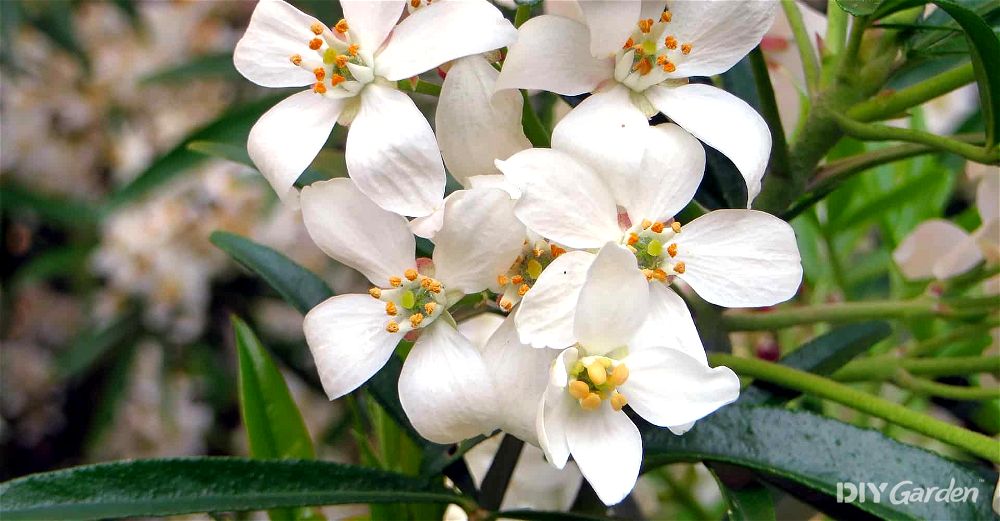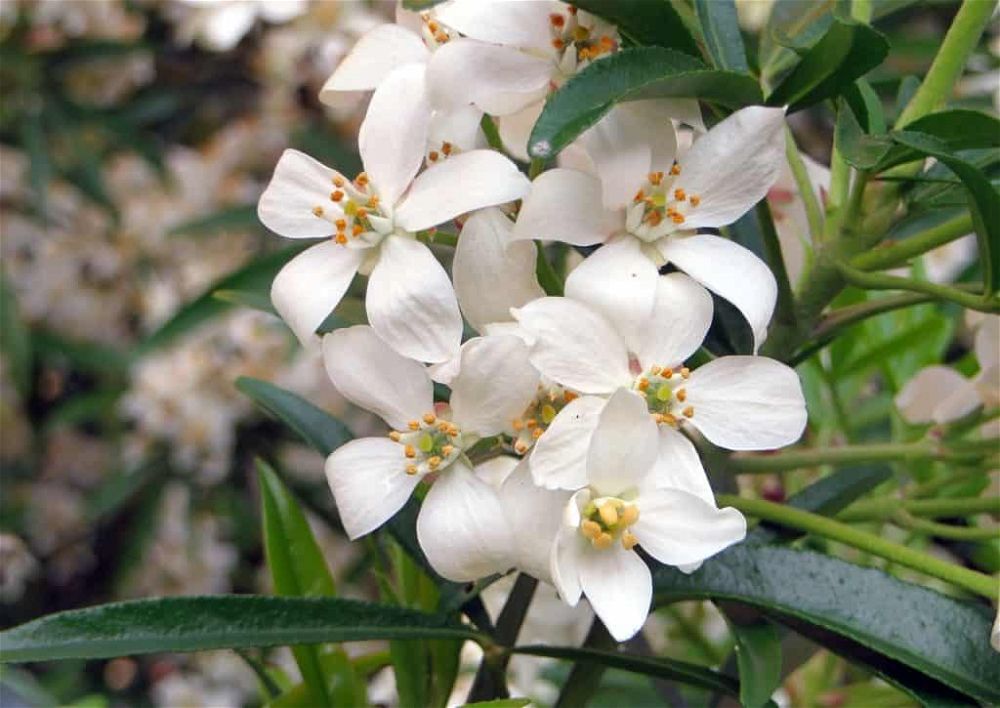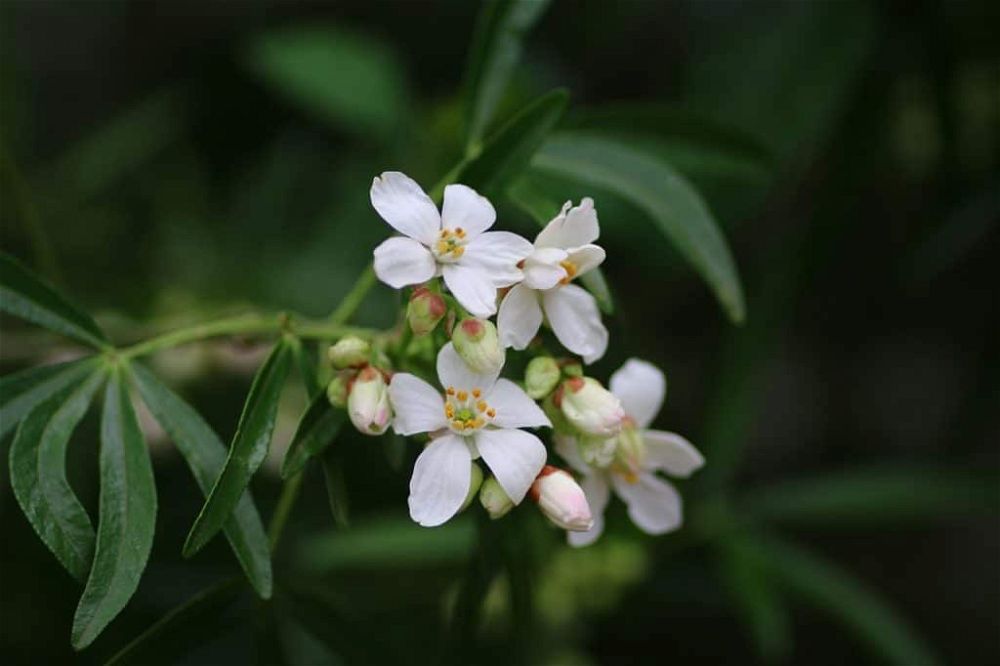
Jump to a Section
Plant Overview
| Common Name | Mexican orange blossom, Mexican orange flower |
|---|---|
| Scientific Name | Choisya Ternata, Choisya grandiflora |
| Plant Family | Rutaceae |
| Origin | Mexico and surrounding areas |
| Height | Usually around 1.8 – 2.5 metres (5-8 feet) for the larger varieties in perfect conditions. There are also more compact varieties available |
| Light | These shrubs do best in full sun but will also grow quite happily in partial shade |
| Temperature | These shrubs will tolerate low temperatures but may suffer some frost damage at temperatures of below -3°C. They can cope with even lower temperatures, down to -7°C or lower, as long as they are protected from cold winds. |
| Hardiness | These shrubs are very hardy, especially if planted in a position that is sheltered from strong winds. It is the combination of cold and wind that can negatively affect these plants |
| Soil | Choisya will grow in most soils expect those that are either extremely acid or extremely alkaline. They do not need a nutrient rich soil and so will do well even in poor soils. However, they will not tolerate very waterlogged conditions. |
| Fertiliser | Fertiliser is not normally required |
| Propagation | Propagate by semi-hardwood cuttings |
| Pests | Slugs and snails |
| Difficulty | Easy |
Choisya ternata, which is commonly known as Mexican Orange Blossom, originated in Mexico and was introduced to Europe in 1826.
This evergreen shrub is grown for its mass of beautiful, star-shaped white flowers. These have a delicate citrus fragrance and flower in late April through May. It also has attractive glossy foliage with leaves that are aromatic and shaped like small palm leaves.
These shrubs are easy to grow and require very little care and attention. They will thrive even in relatively poor soil, require no pruning and are tolerant to many pests and diseases. They are happy in full sun or partial shade.
Because they are easy to grow and provide such lovely foliage in the garden they are an ideal shrub for the busy gardener.
Read on to find out how to choose and care for your Choisya ternata.
Choisya Ternata Care
Choisya shrubs are easy to grow and care for. Once established they require little in the way of care and attention and will reward you with abundant flowers and glossy foliage year after year.
Light Requirements
The positioning of your plant will depend on its variety. Some will tolerate more shade than others so check the details of the variety you choose. Always position your shrub in a spot that is sheltered from strong winter winds.
Water Requirements
In the first year, make sure your shrub does not dry out. Once established, Choisya is a drought resistant shrub and will usually look after itself. They will only need watering during prolonged dry spells. In periods of drought, a thorough soaking weekly will suit them perfectly.
Soil Requirements
Choisya is happy growing in loam, chalk, sand or clay. They do not require a very rich soil to grow either. The only thing that they cannot tolerate is waterlogged soil as this will cause the roots to rot.
Fertiliser Requirements
Your Choisya will generally not require any fertiliser. In very poor soil you may like to add a handful of blood, fish and bone before planting and then again, each spring. Very heavy or waterlogged soil should have some well-rotted manure and horticultural grit dug in before planting.
Planting
You can plant your Choisya at any time of year as long as the soil is not frozen. If you plant it during a very dry period be prepared to water your shrub regularly until it is well established, so don’t plant it just before you go on holiday!
Ideally, plant the shrub in mid-March to April or mid-September to October as at these times the weather is mild but not too hot and the natural rainfall will usually be enough to get them established. If planted at these times you can usually just put them in and forget about them.
Choose a spot that has enough sun for the variety you have chosen and that is protected from strong winds. Allow enough space for them to grow to their full height and spread bearing in mind that some varieties have a spread of 2.5 metres (8 feet).
If the soil is poor, dig in some well-rotted manure before planting. If the soil is waterlogged dig in some well-rotted manure or plenty of horticultural grit to improve drainage.
Dig a hole twice the width of the rootball. Add any fertiliser or grit required. You can also add a handful of blood, fish and bone at this stage to get your shrub off to a good start. Place the plant in the hole so that it is at the same depth as in the pot. Backfill around the roots and firm the soil to remove any air pockets. Water well to settle the soil around the roots.
If you are planting a choisya in a pot its advisable to choose one of the more compact varieties and plant it in a fairly large pot to accommodate plenty of root growth. It will need a good soaking, preferably with rain water, once a week.
Maintenance
When the plants are young, weeding around them will keep them healthy. Once they are larger they will crowd out any weeds themselves. An annual mulch around the shrub will also help keep the weeds at bay as well as retaining moisture. Keep the mulch a few centimetres away from the plants stem to avoid rotting.
If you need to move your shrub, some care should be taken to make sure you do not damage the roots too much. Damage to the roots can mean the plant struggles to get enough water and nutrients. The best solution is to prune the shrub back in June so that there is less top growth for the plant to support and then move it in autumn. Try to dig up as much of the root ball as possible though if the plant is large you may not be able to get all the roots. Add a little blood fish and bone to the new hole to help the plant recover and keep it well watered if the weather is dry.
Plant grown in containers may need some extra winter protection as they are more susceptible to frost damage. Place the plant in a sheltered position such as an open porch or in a sheltered corner. You can also protect your shrub with bubble wrap around the pots to keep the roots cosy. If you put your plant under cover remember to water, it regularly over winter. In extreme conditions, you can move the pot into a shed, greenhouse, or even a garage for a week or two.
Repotting
You should repot your choisya when its roots fill the existing pot. Choose a container that is large enough to accommodate a good amount of root growth. This will also mean in requires less frequent watering and will also help to protect the roots during cold spells
Looks Good With
Choisya ternata is a versatile shrub that looks good in both an urban garden or a more cottage style scheme. The leaves and flowers are scented, and the aroma of the leaves is released as you brush past it. Combined with other fragrant plants or herbs this would make a good choice for around a path or seating area.
This shrub is also a useful addition to a mixed border as it adds height, structure and winter interest. ‘Sundance’ is particularly good in a warm, bright border surrounded by other sunshine-loving plants. The shrub looks good in a coastal style garden and will tolerate salty conditions as long as it is not too exposed to sea breezes.
Pruning Advice
These shrubs do not really require pruning.
However, if you do want to prune them to keep them to a certain size it’s best to do this immediately after the major flowering period is over, usually around mid-June. You can cut it back to around half its size. You may also like to cut back some of the woody stems from the centre of the shrub which will encourage fresh new growth. A sprinkle of blood, fish and bone will help the plant recover after pruning.
Choisya Ternata Propagation
Choisya can be propagated by seed, but the most reliable method of propagation is by semi-hardwood cuttings
Propagating Choisya From Cuttings
Cuttings should be taken when new growth is just becoming woody at the base but is still flexible at the tip, this is usually in late summer.
- Prepare pots with a mixture of half potting compost and half grit to improve drainage. Make holes for the cuttings with a pencil or small stick.
- Remove the soft tip of the stem and divide the rest of the stem into 10-15 cm (4-6-inch) cuttings, ensuring that the base of each cut is just above a leaf node. You should remove the lower leaves from each cutting. Dip the base of each cutting in rooting hormone powder to encourage the development of roots as well as discouraging rotting.
- Place each cutting in a prepared pot to a depth of around 5 cm (2 inches). Water gently.
- Cover the pots with loose plastic bags secured these with an elastic band. This will reduce moisture loss. Place them in a sheltered spot or in a cool greenhouse out of direct sunlight. The cuttings can also be placed on a north or west facing windowsill, however, they will need careful hardening off before they are moved outside.
- Once a week, remove the plastic to water your plants, give them an airing and remove any dead or dying material.
By the following spring, the cuttings should be ready for hardening off and planting out.
Common Choisya Ternata Problems
As a relatively hardy plant, Choisya ternata isn’t affected by many pests or diseases. There are just a couple of things to look out for.
Pests
Choisya ternata is rarely affected by pests. This is probably because of the scented oils in their leaves.
Slugs
Occasionally there may be some slug damage to young plants which can usually be solved by sprinkling dry compost around the plant or something equally gritty that the slugs won’t want to crawl across.
Diseases
Choisya is usually disease free. However, occasionally it may be affected by Phytophthora root rot.
Phytophthora Root Rot
This will result in wilting and dieback and is often fatal to the plant. Root diseases can be avoided by improving drainage and avoiding overwatering.
Choisya Ternata Varieties
Choisya ternata
The original Choisya ternata has dark green leaves and white flowers in spring. The flowers have a delicate citrus fragrance. This variety will also often produce a second flush of flowers in early autumn. This is the best choice if you are looking for a shrub for a semi shaded area as it tolerates shade better than other varieties. It also has the most flowers of all the varieties.
This shrub will reach an ultimate height of around 2.5 metres in (8 feet) in 10-20 years.
Choisya ternata ‘Aztec Pearl’
This variety has slender dark green leaves. It also features clusters of white flowers which are lightly tinged with pink in late spring and early summer. The flowers also feature prominent golden stamens and have a strong citrus scent. It prefers a sunny site though it can tolerate part shade. It will do best in well-drained soil.
This variety will reach an ultimate height of 2.5 metres (8 feet) in around 10-15 years.
Choisya ternata ‘White Dazzler’
This variety forms a compact mounded shrub and is suitable for a smaller garden or for growing in a pot. It will generally not need pruning. It can also be used as a low hedge. It has slender dark, green leaves which are lighter when they first appear. The shrub produces an abundance of flowers in late spring and often again in summer and autumn. This variety prefers a position in full sun but is also the hardiest of all the Choisya varieties.
The shrub will reach an ultimate height of around 0.5 – 1.2 metres (4 feet) in around 5 years.
Choisya ternata ‘Sundance’
This variety is popular because of the beautiful colour of the foliage. The leaves start off golden, sunny yellow and age to a delicate lime green. The foliage looks good all year round but is particularly colourful from March to November. However, it still adds a splash of welcome colour in the winter garden. You will get the best colour from this shrub if you plant it in full sun.
The clustered white flowers have a citrus scent and appear from late April until June and the shrub sometimes produces a second flush of flowers in October though this is less reliable than with the original ternata.
This variety will reach an ultimate height of around 2.5 metres (8 feet) in around 5- years.
FAQs
If the new growth looks healthy I suspect that the dieback has been caused by cold weather. Choisya does not like the combination of very cold temperatures and very cold winds. The good news is that your plant should be fine. Once the weather warms, just cut back the damaged foliage and it will soon be looking great once more.
As these are new plants it is unlikely that they need extra fertiliser. In addition, as they are in full sun it is not lack of light. I think the most likely problem is poor drainage. You might like to check the soil with a moisture metre. Even if you are only watering once a week this might be too much if the soil is slow to drain.



Share